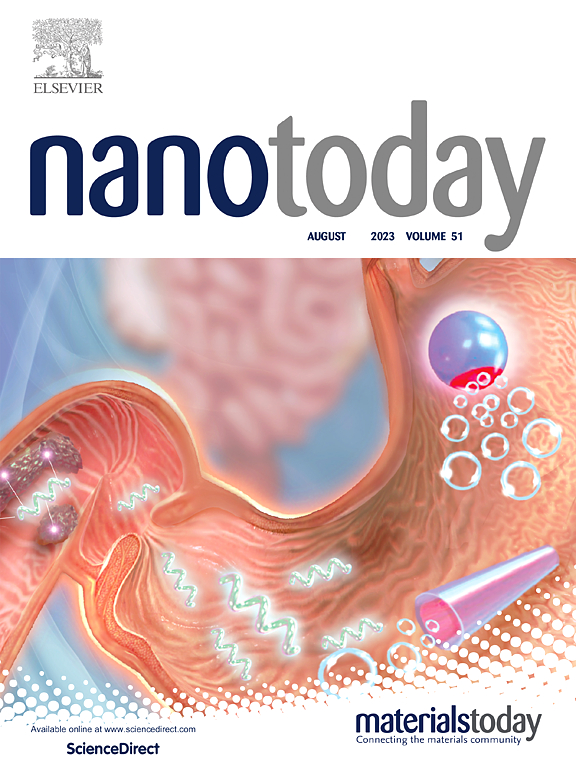Broad-spectrum utilization and direct energy transfer from lanthanide nanoparticles for sunlight-triggered low-dose, highly efficient photodynamic therapy
IF 13.2
1区 材料科学
Q1 CHEMISTRY, MULTIDISCIPLINARY
引用次数: 0
Abstract
Antibacterial photodynamic therapy (aPDT) is an emerging and promising approach for addressing microbial contamination and antibiotic resistance. However, achieving efficient aPDT at reduced doses and under low light-intensity light remains a significant challenge. In this study, an aPDT strategy using solar irradiance intensity was proposed by designing a multifunctional antibacterial nanoplatform, denoted as YVO4:Bi3 +,Eu3+/TiO2-Ce6 (YTiC), based on rare-earth nanomaterials (YVO4:Bi3+,Eu3+) loaded with Ce6 and TiO2. The YVO4:Bi3+,Eu3+ serves as a carrier for Ce6 and TiO2, modulating aggregation state, optimizing light absorption, and suppressing electron-hole recombination in TiO2. The important innovation in this design is that YVO4:Bi3+,Eu3+ can convert UV light to red light to activate Ce6 and directly sensitize its triplet state via the 5D0–7F2 transition of Eu3+, thereby significantly boosting reactive oxygen species (ROS) production. This strategy reduces the required Ce6 dose by 46 % and light power density by 50 %, substantially enhancing ROS generation efficiency. Furthermore, combining aPDT with sonodynamic therapy (SDT) achieved near-complete bactericidal efficacy against Staphylococcus aureus, Salmonella typhimurium, and Botrytis cinerea, by inhibiting bacterial glycogen metabolism and disrupting the arginine and proline metabolism pathways. Based on this platform, the multifunctional antibacterial film YTiC-CMC is developed, enabling UV irradiation and sunlight to extend the shelf life of strawberries and chicken by 4 and 3 days, respectively, achieving outdoor antibacterial action and food preservation. This rare-earth nanomaterial-enhanced synergistic strategy offers a novel and powerful pathway for combating microbial contamination in both clinical applications and food preservation.
广谱利用和直接能量转移从镧系纳米粒子在阳光触发的低剂量,高效光动力治疗
抗菌光动力疗法(aPDT)是一种新兴的、有前途的解决微生物污染和抗生素耐药性的方法。然而,在低光强光下实现低剂量高效aPDT仍然是一个重大挑战。本研究基于稀土纳米材料(YVO4:Bi3+,Eu3+)负载Ce6和TiO2,通过设计多功能抗菌纳米平台YVO4:Bi3 +,Eu3+/TiO2-Ce6 (YTiC),提出了利用太阳辐照强度的aPDT策略。YVO4:Bi3+,Eu3+作为Ce6和TiO2的载流子,调节了TiO2的聚集态,优化了光吸收,抑制了TiO2中的电子-空穴复合。该设计的重要创新之处在于,YVO4:Bi3+,Eu3+可以将紫外光转化为红光激活Ce6,并通过Eu3+的5D0-7F2跃迁直接敏化Ce6的三重态,从而显著促进活性氧(ROS)的产生。该策略将所需的Ce6剂量降低了46% %,光功率密度降低了50% %,大大提高了ROS的生成效率。此外,aPDT联合声动力疗法(SDT)通过抑制细菌糖原代谢和破坏精氨酸和脯氨酸代谢途径,对金黄色葡萄球菌、鼠伤寒沙门氏菌和灰葡萄杆菌具有近乎完全的杀菌效果。基于该平台,开发了多功能抗菌膜YTiC-CMC,通过紫外线照射和阳光照射,可以将草莓和鸡肉的保质期分别延长4天和3天,实现户外抗菌作用和食品保鲜。这种稀土纳米材料增强的协同策略为临床应用和食品保存中对抗微生物污染提供了一种新颖而有力的途径。
本文章由计算机程序翻译,如有差异,请以英文原文为准。
求助全文
约1分钟内获得全文
求助全文
来源期刊

Nano Today
工程技术-材料科学:综合
CiteScore
21.50
自引率
3.40%
发文量
305
审稿时长
40 days
期刊介绍:
Nano Today is a journal dedicated to publishing influential and innovative work in the field of nanoscience and technology. It covers a wide range of subject areas including biomaterials, materials chemistry, materials science, chemistry, bioengineering, biochemistry, genetics and molecular biology, engineering, and nanotechnology. The journal considers articles that inform readers about the latest research, breakthroughs, and topical issues in these fields. It provides comprehensive coverage through a mixture of peer-reviewed articles, research news, and information on key developments. Nano Today is abstracted and indexed in Science Citation Index, Ei Compendex, Embase, Scopus, and INSPEC.
 求助内容:
求助内容: 应助结果提醒方式:
应助结果提醒方式:


